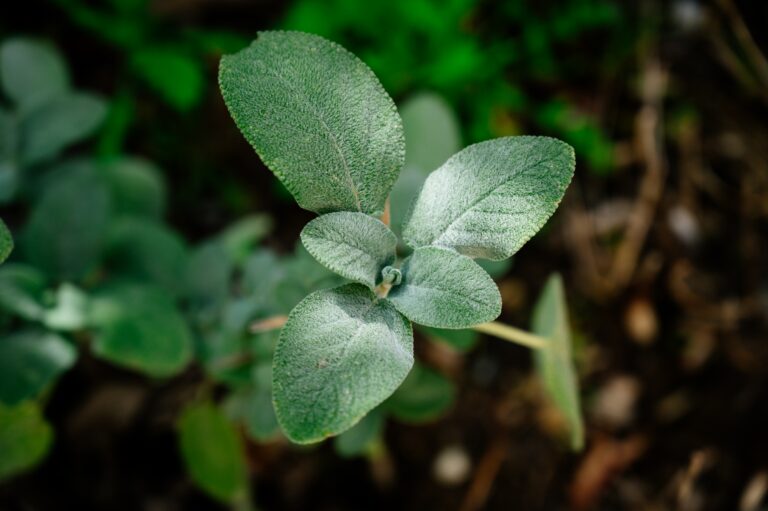This remarkable herb, known by its botanical name Salvia officinalis, has captured the hearts of gardeners and herbal enthusiasts alike for centuries.
Originating from the sunny Mediterranean region, sage brings a touch of warmth and vibrancy to any garden. With its beautiful velvety gray-green leaves and delicate purple flowers, sage is a sight to behold. But its allure doesn’t stop there! This herb is not only a delight for the eyes but also for the senses. Sage leaves release a heavenly aroma when crushed, and they have long been cherished for their culinary and medicinal properties. Whether you’re adding its distinct flavor to savory dishes or seeking its therapeutic benefits in herbal remedies, sage is a true companion in both the kitchen and the garden.
How to care for sage?
Sage is a herb that does not require much attention. For woody or leggy plants, the stems should be cut back to the size you want and then you need to repot the sage. It can withstand overwintering well and is well protected against pests. To make sure the sage overwinters, place the plant where it will not be exposed to cold winds. For pests, remove any dead leaves and apply insecticidal soap.
How to avoid woody sage plants? Just place the sage in a place where each part (both stem and leaf) receives adequate and even light. The cause of leggy sage is usually uneven light exposure, which is why one must be careful when pruning to cut the leaves off the plant so that they do not cover each other.
How much water does sage need?
Keep your sage content with moderate moisture levels, and it’ll tolerate some dry spells too. Young plants prefer even soil moisture, while established ones need a drink when the top 1 to 2 inches of soil dry out.
What kind of soil does sage need?
Create a cozy home for your sage with sandy or loamy soil that drains well. Remember, wet feet can lead to rot! Aim for a slightly acidic to neutral soil pH for optimal growth.
How much light does sage need?
Sage craves the sun’s warm embrace, so give it at least six hours of direct sunlight each day. However, if you’re in zone 8 or higher, a touch of afternoon shade will keep it cool during scorching weather.
What are the essential temperature conditions for sage?
Can handle a bit of frost, but it flourishes best in temperatures between 60 and 70 degrees Fahrenheit. It appreciates moderate humidity, so if you’re in a high-humidity area, ensure good airflow to discourage fungal growth.
How to overwinter sage?
Sage easily overwinters in the cold because it can tolerate temperatures down to USDA zone 4, so -30°F (-34.4°C) to -25°F (-31.7°C). Beyond these, keep an eye on the plant at all times, because sometimes they can surprise you. To protect the herb from cold winds, a greenhouse is a perfect shelter. The key to protection is to keep the leaves out of cold winds, which can damage them. Leaving sage in the full sun for the winter can also help reduce the risks of cold damage.
How to propagate sage?
Using Stem Cuttings allows you to expand your sage family and rejuvenate mature plants in a budget-friendly way. Or you can opt for growing your sage from seeds – which requires a bit more patience. Plant them about 1/8 inch deep in moist garden soil or seed-starting mix. Keep the soil lightly moist, not soggy. Remember, germination may take up to six weeks. Enjoy the journey of nurturing your sage from tiny seeds into a flourishing herb garden!
How to prune sage?
Picture this: you’re strolling through a vibrant garden, filled with beautiful flowers. But wait, some of the flowers have faded and lost their charm. That’s where deadheading comes in! It’s like a magic trick to keep your plants looking fresh and encourage them to bloom again. Learn how to prune your common sage.
After the initial burst of flowering, don’t be afraid to give your plants a little TLC. Deadhead those faded flowers and watch as new shoots emerge, adorned with vibrant leaves. And here’s a pro tip: older plants love an annual hard prune. It’s like a rejuvenating spa treatment for them!
If you want your sage to be the superstar of your herb garden, don’t skip the pruning session. Give those established sage plants a hard prune in early spring. This will work wonders, promoting lush, bushy growth and a profusion of fresh, flavorful leaves.
Remember, if you neglect pruning, older sage plants might end up looking straggly and sprawling, with a bare and uninspiring center.
